User:Tocharianne/pasta
This is the text from the articles linked to List of pasta to avoid people having to click on every link.
Shaped pasta
[edit]Campanelle
[edit]Campanelle is a type of pasta which is shaped like a small bell or flower. (Campanelle is Italian for little bell.) It is also sometimes referred to as gigli or riccioli. It is intended to be served with a thick sauce, or in a casserole.

Cavatelli is a small, shell-shaped pasta with a rolled edge. It is similar in shape to casarecci, but shorter in length. The pasta is typically sold refrigerated.
Some Italian-Americans in the New York area refer to the pasta as "gab-a-deel" or "cav-a-dell" (among other pronunciations) instead of cavatelli. Such corrupted pronunciations have their origin in various Southern Italian dialects. Italian-Americans who are educated in the Italian language, however, refer to the pasta by its correct Italian name.
Some people confuse cavatelli with another pasta product, gnocchi. Cavatelli are made of flour and water. Gnocchi (pronounced nyo-kee) are made with mashed potatoes, water, salt and flour.
Cencioni
[edit]
Cencioni is a type of pasta.
The name derives from the Italian for little rag.
Cencioni are oval and petal-shaped, with a slight curve, larger and flatter than orecchiette, with a more irregular shape and a rough texture to one side to help sauces cling better.
Conchiglie
[edit]
Conchiglie is a type of pasta.
Commonly known as "seashells", the name derives from the Italian word for seashell.
Farfalle
[edit]
Farfalle is a type of pasta.
Commonly known as "bow-ties" the name derives from the Italian for butterfly.
Farfalle comes in several sizes, but has a distinctive bowtie shape, like a little Action Man bowtie (a satirical quote from Alan Partridge). Usually the farfalle is formed from a square of pasta with two sides trimmed in a ruffled edge, and the center pinched together to make the unusual shape. They are sometimes ridged, known as farfalle rigate. Different colors are available; plain, tomato, and spinach. These are often sold together in a mix. Suitable for most sauces, farfalle are very well suited to cream and tomato dishes, and children have a particular affinity for them.
In Modena farfalle are known as strichetti.
A larger variation of farfalle is known as farfallone.
For some unexplained reason, farfalle is considered "Dead To Me" by Stephen Colbert.
Fiori
[edit]
Fiori is a flower-shaped pasta.

Fusilli, a helical shaped pasta, is usually about 4 centimetres long. Fusilli is almost identical to another shaped pasta called Rotini. They both have the spiral shape, although rotini is slightly bigger and thicker than fusilli.
Fusilli is often made in green and red varieties - these are produced by adding spinach and carrots respectively.
In popular culture
[edit]The pasta is prominently featured in the Seinfeld episode, "The Fusilli Jerry".
Gemelli
[edit]
Gemelli is a type of pasta.
The name derives from the Italian for twins.
Gemelli are not twin tubes twisted one another, but rather a single s-shaped strand twisted into a spiral.
Gigli
[edit]Gigli redirects to campanelle
Lanterne
[edit]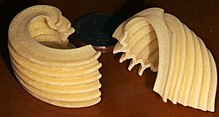
Lanterne is a type of pasta.
The name derives from the Italian for oil lantern.
Lanterne have deep ridges and are curved in a lantern shape.
Orecchiette
[edit]Orecchiette is a type of pasta native to Apulia, whose shape is approximately that of a small ear (in Italian, ear is "orecchio"). In the Taranto area it is still called by the synonym "chiancarelle". An orecchietta is about 3/4 of an inch in size and looks like a white small dome with a thinner center than edge and a rough surface.
A different, non-dome shaped version is called "strascinate". Like most pasta, all versions of orecchiette are made with only hard wheat flour, water and salt.
The typical regional recipe couples orecchiette with turnip heads.
Origins
[edit]Orecchiette probably come from the Provence region in France where a similar type of pasta has been made since Medieval times. This kind of pasta is disc-shaped with a hollowed center, usually obtained by pressing the thumb on the disc; this particular shape facilitates the drying process so that the pasta could saved for a famine. Boats leaving for long trips used to carry large quantities of this pasta. It is then claimed that the Anjous, the French dynasty that dominated Apulia in 1200, brought this pasta into Italy with its current name.
Rotelle
[edit]
The name derives from the Italian word for little wheels. They are also known as wagon wheels.
Rotini
[edit]
Rotini is a type of pasta, related to Fusilli, but with a tighter spiral.
The name derives from the Italian for twists.
Rotini originate from Northern Italy and the tight twists help them retain a wide variety of sauces better. They are often used in pasta salads with pesto or tomato based sauces.
Strozzapreti
[edit]Strozzapreti is the name of a variety of regional Italian specialties.
One is a kind of pasta which is laid out flat in sheets then twisted to look like a rolled towel; due to this method of production, each piece of the pasta is markedly non-uniform, unlike spaghetti or macaroni. The pasta originates from the Italian region Romagna.
Another version from Florence consists of small balls of a mixture of spinach or chard, ricotta cheese, Parmesan cheese, flour and seasonings, baked in an oven.
Strozzapreti from Emilia are made from flour, water, Parmesan cheese, and egg whites beaten together.
The name is Italian for "priest choker"; there are several legends to explain the origin of the name. One is that gluttonous priests were so enthralled by the savory pasta that they ate too quickly and choked themselves, sometimes to death. Another explanation involves the azdora [the housewife in Romagna], who ‘chokes’ the dough strips to make the strozzapreti: "... in that particular moment you would presume that the azdora would express such a rage (perhaps triggered by the misery and difficulties of her life) to be able to strangle a priest!" Another legend goes that wives would customarily make the pasta for priests, and their husbands would be angered enough by the venal priests eating their wives' food to wish the priests would choke as they stuffed their faces with it.
Tubular pasta
[edit]Bigoli
[edit]Bigoli is a long, spaghetti-like dry pasta with a hole in the center. Traditionally they were made with buckwheat flour, but are more commonly made with whole wheat flour now. It closely ressembles the bucatini. Bigoli is a term used in Venice, whereas the term pici is used in Tuscany for a similar pasta without the hole in the center; oftentimes, the terms will be used interchangeably.
Definition=
[edit]In "La vecchia cucina eugubina" they say that this noodle is as thick as a stockings-making wooden knitting needle.
Refrences
[edit]- Hyman, Clarissa (September 2, 2006). "Spaghetti con tutti . . . . . . and linguine, rigatoni, bucatini and the rest. Clarissa Hyman gorges herself on an Umbrian outbreak of pastamania". Financial Times; London. Financial Times Ltd.
{{cite news}}:|access-date=requires|url=(help) - Gianotti, Peter M. (July 19, 2006). "Fresh seafood with an Italian accent". Knight-Ridder/Tribune Business News. Newsday Inc.
{{cite news}}:|access-date=requires|url=(help)
Bucatini
[edit]
Bucatini is a thick spaghetti-like pasta with a hole running through the middle. The name comes from buco, meaning "hole" in Italian. It tastes similar to spaghetti, but is thicker, with almost a vermicelli texture. Originating in Sicily, Bucatini is good with semi-thick sauces, or just buttered with spices.
See also
[edit]Cannelloni
[edit]
Cannelloni, or manicotti, are large tubes of pasta, generally 3 to 4 inches in length and one inch in diameter. After boiling, they are typically filled with a savory stuffing of ricotta cheese or meat, then covered with tomato sauce. However, there are many variations on the basic recipe.
In Italian, cannelloni literally means "big pipes" or "big reeds", while manicotti means "muffs", from the diminutive of manica ("sleeve"). Although both terms are plural nouns in Italian, the English term is often construed as singular, particularly when used as the name of the dish.
The term manicotti is more common in the United States, but they can be used interchangeably. However, an article in Better Homes and Gardens magazine distinguishes them, using manicotti for noodles rolled diagonally and cannelloni for noodles rolled rectilinearly. [1]
The American composer Peter Schickele has called for an uncooked manicotti tube, which he calls "pastaphone," to be used as a musical instrument (played in the manner of a horn) in works by the fictional composer P. D. Q. Bach.
Cavatappi
[edit]
Cavatappi is a "S" shaped macaroni noodle. Cavatappi means "corkscrew" in Italian.
External links
[edit]Cellentani
[edit]
Cellentani is a form of tubular pasta.
Fideuá
[edit]Fideuá (pronounced "fee-theh-WAH", IPA /fiðe'wa/; from "fideu", Catalan/Valencian for noodle) is a typical dish of Valencia, Spain. It is a variation of the popular paella dish, originated in the 1960s in the city of Gandia when noodles were put instead of rice, because someone forgot to bring the rice. There are many variations of it with different ingredients, but it is usually made with seafood and fish, and optionally served with allioli sauce.
External links
[edit]- [2] Simply Delectable Seafood Fideuá.
Elbow Macaroni
[edit]

Elbow macaroni is a term for pasta in the shape of a small tube curved into a semicircular shape. (See also macaroni.) Its name comes from the similarity of its shape to that of a bent elbow. Elbow macaroni is commonly used in macaroni and cheese and other dishes.
Elbow Macaroni is produced by extruding dough through a circular die with a pin or disk in the center that forms the tunnel. The geometry of the die forces more dough through one side of the circle than the other, forming the characteristic curve. The images show front and rear views of an elbow macaroni die which extrudes five pieces at once. In this die, more dough is directed to the outside of the circles than the inside, and the extruded macaroni curls inward.
Macaroni
[edit]
Macaroni is typically machine-made dry commercial pasta, used in contrast to fresh pasta made at home or in small local businesses. Macaroni technically must not contain eggs. Although usually commercially made, some more advanced home machines do allow for the fresh creation of macaroni pasta noodles.
Macaroni is a corruption of the Italian word maccherone and its plural maccheroni. Its etymology is debatable. Some scholars think it's related to Greek makaria, a kind of barley broth. Others think it comes from Italian maccare, "to bruise or crush" (referring to the crushing of the wheat to make the pasta), which comes, in turn, from Latin macerare.
Thomas Jefferson is credited with introducing the first macaroni machine in the United States, in 1789, when he returned home after serving as ambassador to France. He said that Daniel Paese taught him all he learned about this machine. The word macaroni was already familiar in the U.S. at that time, having appeared in the previous decade in the lyrics of the popular song "Yankee Doodle", in which the titular character "stuck a feather in his cap and called it macaroni"; this usage had to do with the Macaroni fashion.
In English-speaking countries, the name macaroni is customarily given to a specific shape of pasta: small pasta tubes cut into short pieces. In the United States macaroni is also sometimes labelled as elbow macaroni, or more simply elbows, due to the slight bend in the shape of the pasta noodle. In the U.S. and the United Kingdom, this pasta is often prepared by baking it with a sauce made from cheddar cheese; the resulting dish is called macaroni and cheese (often shortened to macaroni cheese in Britain, and "Mac'n'cheese" in the U.S.). In some parts of the U.S., a more narrow type of macaroni is sold as elbow spaghetti.
Among some Italian-Americans (particularly in New York City, Philadelphia, and New Jersey), macaroni is used as a generic term for any type of pasta. Such usage, however, is not technically accurate.
External links
[edit]Manicotti redirects to cannelloni
Mezzani links to an article on the commune in Italy
Mostaccioli redirects to penne
Penne
[edit]- For other meanings, see Penne (disambiguation).

Penne are a type of pasta originating in Italy. They have a cylindrical shape. The ends are almost always cut diagonally. The name is derived from penna, which is Latin for "feather" or Quill.
Rigatoni
[edit]
Rigatoni is a form of tube-shaped pasta. It is larger than penne and ziti. Rigatoni is usually ridged and the tube's end does not terminate at an angle, like penne's does.
Rigatoni can be coupled with many different sauces, from creamy to chunky. Consequently, rigatoni is a popular choice for restaurants which choose to stock only one tube-shaped pasta noodle. The tube may be stuffed with cheese or other soft foods.
The word rigatoni comes from the Italian past participle of rigare, which means "to draw a line" (American Heritage Dictionary).
References
[edit]Scoobi Do redirects to cavatappi
Ziti are macaroni tubes sized smaller than rigatoni but larger than mezzani. The addition of the word rigati (e.g. ziti rigati) denotes lines or ridges on the pasta's surface.
Ziti is Italian for "a bridegroom." Although the common form of modern ziti is about two inches in length, the name makes more sense when considering the original, classic form of ziti, which was over 18 inches long.
See also
[edit]Strand noodles
[edit]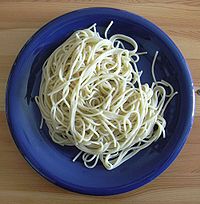


Spaghetti is a long, thin form of pasta. It is versatile, popular, and available throughout the Western world. Spaghetti is the plural form of the Italian word spaghetto, which is a diminutive of "spago," meaning "thin string" or "twine". The word "spaghetti" can be literally translated as "little strings."
Preparation
[edit]Most spaghetti sold and consumed is commercially prepared, then dried. Spaghetti is cooked by boiling the pasta in salted water until soft. The consistency or texture of spaghetti changes as it is cooked. The most popular consistency is al dente which is translated from the Italian as "to the tooth"; that is soft but with texture, sometimes even with bite in the centre. Others prefer their spaghetti fully cooked, which gives it a much softer consistency. The best dried spaghetti is made from durum wheat semolina. Fresh spaghetti should be prepared with grade '00' flour. Inferior spaghetti is often found produced with other kinds of flour, especially outside Italy.
An emblem of Italian cuisine, spaghetti is frequently served in tomato sauce, which may contain various herbs (especially oregano and basil), olive oil, meat, or vegetables. Other toppings include any of several hard cheeses, such as Pecorino Romano, Parmesan or Asiago. Outside Italy it is often served with meatballs, although that is not a typical Italian recipe.
Eating
[edit]According to Neapolitan habit, eating spaghetti with a fork and a spoon is perfectly polite, though the view on this varies in other cultures. Many other Italians eat it with just a fork like most other Continental dishes. In Asia, many people use chopsticks as a form of eating rather than forks, as chopsticks are custom in most Asian countries. In parts of the US, a narrow size of macaroni is sold as elbow spaghetti. This is a misnomer, as this product is short and tubular, thus it's not a spaghetti at all.
Spaghettini (thin spaghetti) takes less time (usually two minutes less) to cook to al dente form than regular spaghetti. There is also Spaghettoni (thick spaghetti) that would take longer to cook. All three types of spaghetti are larger than the other round-rod pastas (like vermicelli).
See also
[edit]External links
[edit]- An article about pasta contains detail about date of spaghetti in Italy
- How to cook pasta with step-by-step pictures
- How to eat spaghetti "properly" with a fork
'Spaghettini redirects to spaghetti
'Spaghettoni redirects to spaghetti
Vermicelli (Italian, ver-mih-CHEL-lee, literally, “little worms”) is a type of pasta, round in section and somewhat thinner than spaghetti.
Vermicelloni (ver-mih-chel-OH-nee, “thick vermicelli”) is less common, and about the same size as fedelini (also hard to find). Both are thinner than spaghettini (“thin spaghetti”).
In 14th-century Italy, extra-fine spaghetti had varying local names. "Master Barnaba da Reatinis from Reggio Emilia notes that Tuscan vermicelli are called orati in Bologne, minutelli in Venice, fermentini in Reggio and pancardelle in Mantua." [3]
The first mention of a vermicelli recipe is in the book De arte Coquinaria per vermicelli e maccaroni siciliani (The Art of Cooking Sicilian Macaroni and Vermicelli), compiled by the famous Maestro Martino da Como, unequalled in his field at the time and perhaps the first celebrity chef, who was the chef at the Roman palazzo of the papal chamberlain ("camerlengo"), the Patriarch of Aquileia. In Martino's Libro de arte coquinaria, there are several recipes for vermicelli, which can last two or three years (doi o tre anni) when dried in the sun.
Vermicelli is known as shemai in Bengali and seviyan in Hindi and Urdu. The noodles are used in a number of dishes, including a dessert of fried vermicelli in sweet boiled milk. Vermicelli is used in many parts of India to make a popular dish "Uppuma". The preparation method is simple: Boiling the dry oil roasted vermicelli with choice of vegetables, till it becomes a pasta.
The term rice vermicelli is often used to describe the thin, transparent rice noodles (米粉) popular in China, also known as bee hoon in Hokkien, mai fun in Cantonese, and Bun in Vietnamese.
The fideo is a type of noodle, popular in Mexican cuisine, often referred to in English as "vermicelli."
Trivia
[edit]- Is the type of pasta/rice cooked to make "Rice-A-Roni"
External links
[edit]Vermicelloni redirects to vermicelli
Ribbon pasta noodles
[edit]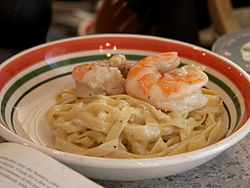
Fettuccine (literally "little ribbons" in Italian) is a type of pasta. It is a very flat, thick, noodle made of egg and flour, similar to tagliatelle.
In Italian cuisine, it is traditionally made fresh (either at home or commercially), but dried versions also exist on the market.
A popular fettuccine dish in North America is fettuccine alfredo.

See also
[edit]

Lasagna, also lasagne, (pronounced /lə'zan.jə/), is both a form of pasta in sheets (often rippled in North America and other countries, though seldom so in Italy) and also a dish, sometimes named Lasagne al forno (meaning "Lasagne in the oven") made with alternate layers of pasta, cheese, and sometimes ragù (a meat sauce). While it is traditionally believed to have originated in Italy, evidence has come to light suggesting that a very similar meal known as "loseyns" (pronounced 'lasan') was eaten in the court of King Richard II of England in the 14th Century. The recipe was also featured in the first cookbook ever written in England. However, the claim is far from universally accepted (see the much earlier Roman use of "lasanum" below). The Italian Embassy in London particularly speaks out against such theories [1]. It has also been claimed that the Scandinavian "Langkake", popular from the Viking ages, is a relative of, or even precursor to lasagne but there is as of yet no evidence that the true lasagne developed from this multilayered dish consisting of flatbread, meat sauce and cheese.
The word "lasagna" is derived from the Greek word "lasanon" meaning chamber pot. The word was later borrowed by the Romans as "lasanum" to mean cooking pot. The Italians then used the word to refer to the dish in which what is now known as lasagna is made. The word lasagna or lasagne (plural) now simply applies to the dish itself. The British (and Italians) generally use the plural "lasagne" to mean both the dish and the pasta while the Americans commonly use the singular "lasagna".
Many recipes call for several kinds of cheese, most often ricotta and mozzarella. The classic Lasagne alla Bolognese uses only Parmigiano Reggiano. Many recipes also add bechamel sauce (besciamella).
A variant is Lasagne verdi (green lasagne) which is the normal egg pasta with spinach added.
Lasagne was first recorded in the 13th century when it was used in a layered dish. This early version did not include tomatoes, which had not yet been discovered by Europeans.
Lasagne in the arts
[edit]- Lasagna is the favorite dish of the fictional cat Garfield.
- Singer "Weird Al" Yankovic’s parody of the song "La Bamba" entitled "Lasagna" can be heard on his album Even Worse.
Lasagne is Italian for Big Lamp Post
See also
[edit]References
[edit]- ^ ""Britain lays claim to lasagne"". BBC News. 2006-10-17. Retrieved 2003-07-15.
External links
[edit]- Lasagna recipes
- Lasagna recipes
- Lasagna Bologna style, step-by-step recipe
- BBC News - "Britain lays claim to lasagne"
- Italian Lasagna recipe
- Cooking For Engineers: Meat Lasagna - recipe for American Italian Meat Lasagna with step-by-step photographs and layering diagrams
- Lasagna recipe - easy lasagna recipe
- Lasagne recipe - Italian lasagne recipe written in english
Linguine (sometimes misspelled linguini) are a wide, flat form of pasta, similar to fettuccine and trenette.
They come from the Campania region of Italy.[citation needed]
The name means "little tongues" in Italian.
Linguine are served in a variety of ways.
Popular culture
[edit]In Chapelle's show, the beatdown that Rick James took was stated to have "his legs look like linguini."

Pappardelle (sg.: pappardella) are large fettuccine. The name derives from the verb “pappare,” to gobble up. The fresh types are two to three centimetres (¾-1 inch) wide and have fluted edges. Dried egg pappardelle have straight sides.
Pizzoccheri are a type of tagliatelle pasta from Valtellina made with buckwheat flour. Classically they are cooked along with greens (often Swiss Chard), and cubed potatoes. This mixture is layered with pieces of bitto cheese and dressed with garlic and sage lightly fried in butter together.
Pizzoccheri can be easily made, similarly to tagliatelle, by hand. They can also be found pre-made.
In Teglio, where pizzoccheri are said to originate, two fairs take place: La Sagra dei Pizzoccheri, celebrated in July and the festival of The Golden Pizzocchero, celebrated in September.

Tagliatelle /taʎʎa'tɛl-le/ is the classic pasta of the Emilia-Romagna region of Italy. Individually, they are long, flat ribbons, similar in shape to fettuccine, but typically about .75 inches long and about two centimetres wide. They can be served with a variety of sauces, though the classic is a meat sauce or Bolognese sauce.
History
[edit]Tagliatelle are an expression of the art of hand-made pasta, because the secret in achieving cooking perfection lies in the ability to roll the pasta evenly, without holes or cuts or difference in thickness.
Legend has it that during the Italian Renaissance, in the year 1487, a talented court chef, inspired by Lucrezia D'Este's hairdo, on the occasion of her marriage to Annibale Bentivoglio, son of Giovanni II, Lord of Bologna created tagliatelle. The recipe was of tagliolini di pasta e sugo, alla maniera di Zafiran (tagliolini of pasta and sauce in the manner of Zafiran) and it was served on silver plates. Over the years, tagliatelle has acquired a much less sophisticated tradition, as tradition wills it to be eaten by simple folk.
Texture and Serving Suggestions
[edit]Since tagliatelle are generally made as fresh pasta, the texture is porous and rough, making it ideal for thick sauces, generally made with beef, veal, or pork, and occasionally with rabbit, as well as several other less rich (and more vegetarian) options; such as briciole e noci (with breadcrumbs and nuts), uovo e formaggio (with eggs and cheese - a less rich carbonara), or simply pomodoro e basilico (with tomatoes and basil).
Trivia
[edit]In Lemony Snicket's A Series of Unfortunate Events, The Carnivorous Carnival Count Olaf's accomplice once threatened the Baudelaire orphans with a Tagliatelle Grande, or really big pasta noodle, that he meant to use as a whip.
Trenette are a type of narrow, flat, dried pasta especially associated with Genoa and Liguria. They are essentially the same as the pasta known as linguine elsewhere in Italy.
Trenette are the most traditional form of pasta served with pesto alla genovese, a dish known as trenette al pesto, which often also includes potatoes and green beans boiled in the same water.
Bibliography
[edit]- Vincenzo Buonassisi, Il Nuovo Codice della Pasta, Rizzoli, 1985, ISBN 88-17-11038-8
Micro pasta
[edit]Acini di pepe are a form of pasta. Italian for "peppercorns", they look like tiny beads.
Acini di pepe works well in soups or cold salads. A common American cold salad recipe that teams the pasta with whipped topping, marshmallows, pineapple and mandarin oranges (incomplete recipe) is often called Frog's Eye Salad.
Also sometimes referred to as pastina (Italian for "tiny dough"), however some pasta makers distinguish pastina as smaller than acini di pepe.
Alphabets Pasta, also referred to as Alfabeto, is pasta that has been mechanicaly cut or pressed into the letters of the Latin alphabet.
Generally the only difference between alphabet pasta and other pasta is its shape. It is often fed to babies and young children.
See also
[edit]References
[edit]- Pasta shapes - An illustrated guide at Food-Info.net

Anellini is a variety of pasta. The word "anellini" means "small rings" in Italian.
Fideo is the Spanish word for a noodle of any type. In Mexico, its name refers to a type of pasta similar to angel hair spaghetti. It is also known as vermicelli.
It is commonly used in making a soup dish. Even though there are a wide variety of recipes for it, the basic recipe calls for lightly browning the fideo in oil. Then adding in a base of chicken or beef broth, with pureed tomato, chile peppers, garlic, and onion. Different recipes may add cilantro, beef, chicken, corn or other ingredients. The mixture is then boiled until the fideo and ingredients are cooked. When served it can be garnished with lime or lemon juice, chile or hot sauce, or white Mexican cheese.

Fregula (aka Fregola) is a type of pasta from Sardinia. It is similar to Israeli couscous. Fregula comes in varying sizes, but typically consists of semolina dough that has been rolled into balls 2-3mm in diameter and toasted in an oven.
A typical preparation of Fregula is to simmer it in a tomato based sauce with clams.
External links
[edit]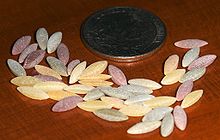
Orzo (from Latin hordeum) is Italian and means "barley," but in common usage in the United States, orzo is understood to mean rice-shaped pasta, slightly smaller than a pine nut. It is frequently used in soups.
Orzo roasted barley drink
[edit]"Orzo" is also the name of a hot drink made from roasted barley in some parts of the world. In Italy, for instance, a "caffé d'orzo" is an espresso style drink made from ground roasted barley. When prepared from the roasted barley directly, it can be made in many standard espresso or coffee makers. Although traditionally considered a coffee substitute for children, it is an increasingly common choice in Italy and other places for those who choose to eschew coffee for health reasons. In the United States, instant roasted barley drinks are sold under the name of "Postum," "Pero," and others, including varieties of "café de cebada" in Latin American markets.
stelle is a page about a town in Germany
Stuffed pasta
[edit]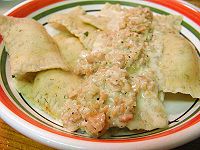
Ravioli is a popular type of pasta, comprised of a filling, commonly (though not always) meat based, sealed between two layers of pasta dough. Ravioli are commonly rectangular or circular in shape.
A common vegetarian option includes ricotta cheese and vegetables such as spinach or nettles in place of meat. The filling could be also potatoes, squash or even tofu. Though often topped with a red, tomato based sauce, the sauces are as varied as the fillings. Pesto, broth based and cream based sauces are also common.
Additionally, other ravioli varieties, like Chocolate Ravioli, have appeared to fill a dessert role.
The word ravioli derives from ravvolgere, the verb meaning "to wrap." Stuffed pasta was probably introduced in the Medieval period in Europe. Pasta was stuffed with meat, fish and vegetables, and could include a creamy cheese like ricotta. Tomato sauce would not have been used, since tomatoes were not introduced in Europe until the 15th century.
In Italy, most regions have their own versions of ravioli, and some of the earliest mentions of the dish come from the personal letters of Francisco di Marco, a merchant of Prato in the 14th century. Though the dish is of Italian origin the oldest known recipe is an Anglo-Norman vellum manuscript from the 1290s.[1]
Today one can find packed refrigerated or frozen ravioli across the world, especially where Italian communities have a certain relief. Ravioli are made in special industrial lines supplied, all over the world, by Italian companies such as Arienti & Cattaneo, Ima, Ostoni, Zamboni, etc.; "fresh" packed ravioli have usually seven weeks of shelf-life.
In Lebanon and Palestine, this dish is called Shish Barak(Shishbarak), the same pasta filled with minced beef meat and cooked in hot yogurt.
Other cultures have parallels to ravioli. The Chinese jiaozi or wonton (indeed in Chinese ravioli and tortellini collectively are called "Italian jiaozi" (義大利餃) or "Italian wonton" (意大利雲吞)), the Russian pelmeni, the Ukrainian varenyky, the Tibetan momo and Jewish kreplachs are a few examples.
Notes
[edit]- ^ Regional Cuisines of Medieval Europe pg. 25
References
[edit]- Adamson, Melitta Weiss; editor (2002) Regional Cuisines of Medieval Europe: A Book of Essays ISBN 0-415-92994-6

Tortellini is a ring-shaped pasta; they are typically stuffed with a mix of meat (pork loin, prosciutto crudo, mortadella) and parmesan cheese, although other stuffings are popular in the Po Valley. Originally from the Italian region of Emilia (in particular Bologna and Modena), they are usually served in broth, with cream, or with a ragù or similar sauce. Traditionally, the most serious restaurant in Bologna as well "La Confraternita del Tortellino" agree that the only real Tortellino is served only in home made broth. Tortellino with cream is widely accepted in Bologna but criticized by some. Tortellino with ragù, although it can be found, is considered by the vast majority of Bolognesi to be non-authentic.
Tortelloni is a larger version of tortellini, and is usually stuffed with Ricotta cheese and leaf vegetables, such as spinach. Many lesser, "exotic" variants exist where the vegetables are replaced with stronger ingredients such as porcini or walnuts. Another common filling for tortelloni is a paste made mainly of pumpkin pulp. Tortelloni are usually served either with ragù or with melted butter and sage leaves.
You can find packed refrigerated or frozen tortellini and tortelloni everywhere in the world, especially where Italian communities have a certain relief. Tortellini and tortelloni are made in special industrial lines supplied, all over the world, by Italian companies such as Arienti & Cattaneo, Ima, Ostoni, Zamboni, etc.; "fresh" packed tortellini and tortelloni have usually 7 weeks of shelf-life.
Mythology
[edit]The origin of tortellini is surrounded by several legends.
One says that this dish is born in Castelfranco Emilia (province of Modena). One night during a trip, Lucrezia Borgia checked into an Inn in the small town. The host was captivated by her beauty and couldn't resist the urge to peek into her room through the keyhole. The light inside the bedroom was only made by a few candles and so he could only see her navel. This pure and innocent vision was enough to send him into an ecstasy that inspired him to create the tortellino that night.
For some the shape of tortellini represents the bellybutton of Venus, the Goddess of Love in Roman mythology (Aphrodite in Greek mythology).
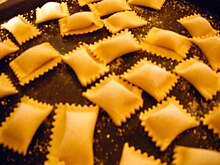
Agnolotti ('priest hats' in Italian) is a kind of ravioli made with a small round piece of flattened pasta dough, folded over with a meat and vegetable stuffing inside. They are prepared by either poaching them or by browning them in a frying pan with butter. This dish is associated with Piedmont in Italy.
Recipes
[edit]Thomas Keller's recipe for pasta dough and agnolotti.[4]
References
[edit]- Lang, Jenifer Harvey, ed. (1988). "Agnolotti". Larousse Gastronomique: The New American Edition of the World's Greatest Culinary Encyclopedia. New York: Crown Publishers. ISBN 0517570327. OCLC 777810992.


A panzarotti is a type of Italian dish popularized in the United States, especially in South Jersey. It consists of a pocket of dough filled with a generous portion of melted mozzarella cheese, tomato sauce, and any number of fillings, which is then wrapped, shut, and deep-fried. The panzarotti rises during this process, creating a pocket containing a considerable amount of steam which needs to be partially dissipated before one can eat the panzarotti. Baked panzarottis also exist, although they are considerably less popular and are more like stromboli than anything else.
The recipe comes from the Tarantini family, which has continually passed down the recipe from generation to generation. Pauline Tarantini, an immigrant mother of 10 who spoke very little English, learned to make panzarottis from her mother in her native Brindisi, Italy. Around 1960 she began producting them by hand from her Camden, New Jersey home. Her husband Leopoldo then sold them at local businesses. The family has been fiercely protective of its claim to the panzarotti and is known for taking legal action against restaurants that copy or imitate the design of the panzarotti.[citation needed] On account of this, panzarottis are generally found exclusively at places owned by the Tarantini family, including the Franco's restaurant in Haddonfield. In fact, Franco's was the original proprietor of the panzarotti.
Mini panzarottis, or panzarottinis, also exist. These are usually sold in groups of five. In November 2006, Franco's introduced an intermediate-sized dish called the junior panzarotti.
In southern Italy the panzarotti is widely spread dish. You can eat Panzarottis in restaurants or easily make them at home (several recipes available online).
Note: In Italy, the spelling is actually panzErotto not panzarotto, and plural panzerotti.
Irregular Shapes
[edit]
Spätzle ([ʃpætslə], German, sometimes explained as being a diminutive of Spatz "small sparrows") are similar to noodles and much used in southern Germany (Baden-Württemberg, Bavaria), western Austria, Switzerland, Alsace and sometimes also in Italy (in South Tyrol and other northern regions in which there they are named in italian "Troffi"). Until the 1950s, Spätzle were also consumed in Malta, where they were called pezzelati, but their consumption declined and came to an end with the introduction of ready-made pasta. The decline was so fast that most Maltese haven't even ever heard of this food.[citation needed] They are fabricated by grating or scraping dough into boiling water and continuously sieving out the batches that are cooked. The dough is a simple affair, consisting of eggs, flour, and salt. Some Spätzle recipes also contain milk or water.
The classic variety are "button" Spätzle (Knöpfle), which are lentil-shaped. If the dough is of firmer consistency, elongated (more noodle-like) Spätzle may be formed. This is the variety that can be purchased dried and packaged.
Spätzle may accompany any meat dish that is generally prepared with a sauce. Examples of variations of Spätzle are:

- eaten with sweet-sour lentils and fine-skinned frankfurter-style sausages in Schwaben, also known as the famous Linsen, Spätzle & Saitenwürstle.
- mixed with fried onions and grated cheese (lots), then fried in a pan or baked in the oven as a substantial main course, mostly in Swabia and Bavaria, as Käsespätzle.
- mixed into a stew as in the Gaisburger Marsch.
However, the most traditional minimalist approach to spätzle serves it with only butter, bread crumbs and a little grated cheese tossed together.
External links
[edit]See Also
[edit]Spätzle is also the name given to a particular genetic mutation of the fruit fly drosophila melanogaster.
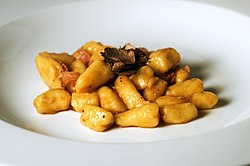
Gnocchi (pronounced /'ɲɔkki/) is the Italian word for dumplings; in Italian, gnocchi is the plural of gnocco, which literally means "lump". They can be made of potato, semolina (durum wheat), flour, or ricotta cheese (with or without spinach). One variety, gnocchi di pane, popular in the Friuli and Trentino-South Tyrol regions, is made from bread crumbs. Although the dish is Italian, the word comes from a Germanic word for a knot (as in wood), possibly because of its short, squat shape.
Gnocchi are often listed among pasta dishes, although gnocchi has different ingredients and mode of preparation. They cook faster than normal pasta and can fall apart if overcooked.
Gnocchi can be purchased dried, or fresh in vacuum sealed packages. The fresh ones are generally considered to be superior. Most people buy their gnocchi premade, which are cooked just like fresh gnocchi. The classic accompaniments of gnocchi are a tomato sauce, a brown butter and sage sauce, or melted butter and cheese.
In the Tuscan area of Italy, spinach-and-ricotta-flavored gnocchi are called strozzapreti, or priest-stranglers. According to popular local legend, a priest choked and died after eating too quickly, because the gnocchi were so delicious.
In Argentina, Uruguay and Brazil, countries where Italian cuisine is especially popular, gnocchi (known as ñoquis and nhoque, respectively) are traditionally eaten on the 29th day of each month. This was the day before payday, when people were at their poorest. Gnocchi made a cheap and hearty meal. On these occasions, some people leave a banknote under the plate to attract prosperity. Now in Argentine communities outside the country, Argentines gather each month for "ñoquis del 29".
In a curious reversal of meaning, in Argentine and Uruguayan slang ñoqui has also become a way to denote a government employee that is listed in the payroll but only shows up to collect his or her paycheck around the 29th of each month.
In popular culture
[edit]In the Australian sketch comedy show, The Ronnie Johns Half Hour, the character Paulie complains to a supermarket that Gnocchi is made from potatoes, and not pasta, and therefore should be stocked in the fruit and vegetable aisle of the supermarket. Throughout the series, Paulie's gnocchi campaign escalates; he stages protests and eventually the mafia attempts to silence him.
See also
[edit]References
[edit]- Jenkins, Nancy Harmon. Flavors of Tuscany. 1998.
